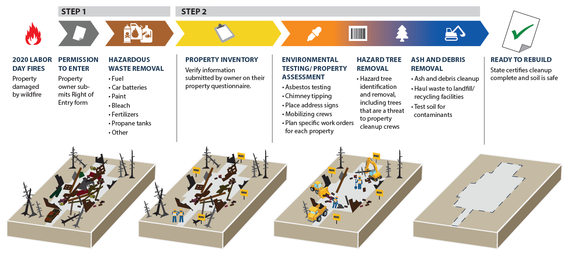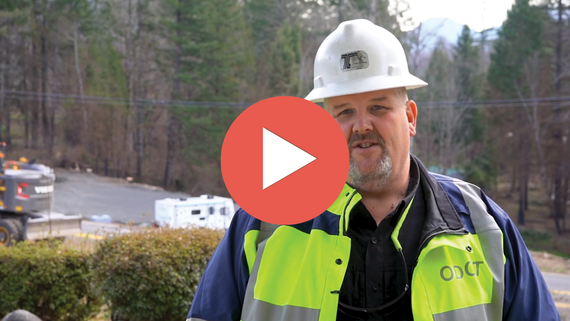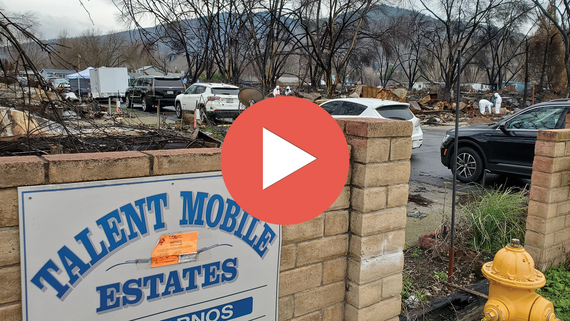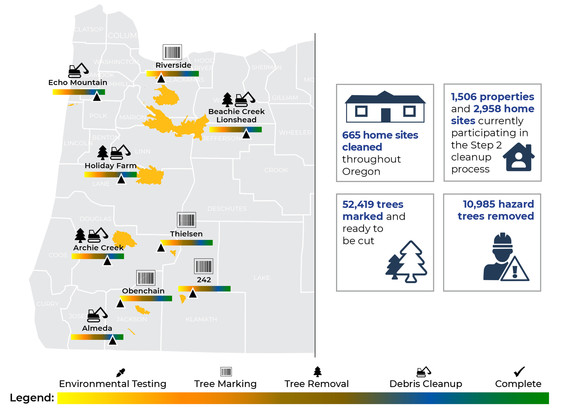|
|
Having trouble viewing this email? View it as a Web page.

March 22, 2021
This monthly newsletter provides the latest information about Oregon's wildfire cleanup effort and what's underway to remove debris and hazard trees following the 2020 Labor Day wildfires.
 5 things to know about wildfire debris and hazard tree removal this month
-
Pace and scale continues to ramp up. Once hazardous materials and waste were removed during the fall and winter of 2020, crews began the process of removing debris from nearly 3,000 home sites and marking and removing more than 290,000 hazard trees starting in January 2021. Two months in, steady progress continues on track with the initial 6-18 month timeline, with sites being completed at various times within this window as crews move to new areas. Given the extreme need, we know that no pace will ever be fast enough, but we’re pushing hard for Oregon.
-
You can track cleanup status any time. Follow along and track what’s happening in your community through our interactive status map and data dashboard (scroll down the page to view). Data can also be tracked by each fire area. For offline options or questions about how to navigate the site, our hotline is available at 503-934-1700.
-
It’s time to submit your Right of Entry agreement, if you haven’t already. We want to ensure that everyone who had property damaged in the fires has the opportunity to participate in our program. So that crews can plan ahead and mobilize to future sites efficiently, please submit your Right of Entry agreement before or as work starts in your area.
-
Take a moment to double-check that your private property questionnaire aligns with local building codes. If you’ve chosen to remove debris yourself, know what’s required before rebuilding. Sometimes the debris removal requests we receive are not aligned with local rebuilding requirements. For example, local codes may have very specific requirements for the condition of home foundations before someone can rebuild. We suggest working with local governments to learn more. If you’ve chosen to remove debris yourself—to ensure your safety and health—please be aware of what’s required before starting.
-
We’re here to help, Oregon. We’re humbled and honored to be able to help during this challenging chapter in Oregon history. We’re all in this together. #OregonRising
 The McKenzie School District reopened its doors this month. We were happy to answer the call.
When the McKenzie School District discovered it was surrounded by nearly 800 hazard trees, it called the Debris Management Task Force to see what could be done so that students could return to the classroom. Watch how task force crews answered the call.
 Helping house Oregonians in southern Oregon, crews clear sites to make way for short-term housing
When Debris Management Task Force staff learned that FEMA needed sites cleared so that they could set up housing for families in southern Oregon, they immediately jumped into action. Watch to see what this means for our neighbors in Jackson County.
 Know where to turn. Stay tuned and track the latest debris news at debriscleanupnews.com
Visit debriscleanupnews.com to track weekly operation updates, browse for answers to your questions, and then bookmark it to share with your networks and community. Content is updated throughout the week. Have an idea for a post or a story submission? Please send us a message at odot.wildfire@odot.state.or.us.
 How are we protecting natural and cultural resources as a key part of this work?
Our natural resources coordinator John Raasch explains.
In case you missed it
|
|
About the Debris Management Task Force
The State of Oregon is working with federal, state and local partners to safely and efficiently remove hazard trees and debris resulting from the wildfires that devastated Oregon in late summer 2020. The Oregon Departments of Transportation and Environmental Quality, and Office of Emergency Management are jointly leading this effort as the Debris Management Task Force.
Hotline: (503) 934-1700 Email: ODOT.Wildfire@odot.state.or.us
|
|
|
You can get this newsletter in other languages, large print, braille or a format you prefer. Contact David Cardona, OEM Language Access Coordinator at 971-719-1183 or email david.cardona@state.or.us. We accept all relay calls or you can dial 711.
¿Habla usted español? Podemos proveer la información en esta publicación en español. Para recibir la información en español, por favor llamé al (503) 731-4128.
|
|
|
|